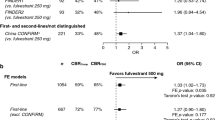Abstract
Fulvestrant (Faslodex™) is a new estrogen receptor (ER) antagonist with no agonist effects that is licensed for the treatment of postmenopausal women with hormone-sensitive advanced breast cancer (ABC) who have progressed/recurred on prior antiestrogen therapy. The Faslodex™ Compassionate Use Program (CUP) provides expanded access to fulvestrant in countries where it is not yet available for patients who are not eligible to enter clinical trials. This analysis pools data from 402 patients who received fulvestrant as part of the CUP in Belgium, predominantly as 3rd- to 5th-line endocrine therapy for ABC. Two patients experienced partial responses and 118 experienced stable disease lasting ≥6 months, resulting in an overall clinical benefit rate of 29.9%. Fulvestrant was active in patients with multiple sites of metastases, visceral metastases, human epidermal growth factor receptor 2-positive disease and after heavy endocrine pre-treatment. Fulvestrant was well tolerated, with only six patients (1.5%) discontinuing treatment following adverse events. These data support the findings of previous CUP analyses and Phase II and III trials, suggesting that fulvestrant is a valuable addition to the treatment sequence for postmenopausal women with ABC who have progressed/recurred on prior endocrine therapy.



Similar content being viewed by others
References
Robertson JF, Nicholson RI, Bundred NJ et al (2001) Comparison of the short-term biological effects of 7alpha-[9-(4,4,5,5,5- pentafluoropentylsulfinyl)-nonyl]estra-1,3,5, (10)-triene-3,17beta-diol (Faslodex) versus tamoxifen in postmenopausal women with primary breast cancer. Cancer Res 61:6739–6746
Wakeling AE (1995) Use of pure antioestrogens to elucidate the mode of action of oestrogens. Biochem Pharmacol 49:1545–1549
Wakeling AE (2000) Similarities and distinctions in the mode of action of different classes of antioestrogens. Endocr Relat Cancer 7:17–28
Wakeling AE, Dukes M, Bowler J (1991) A potent specific pure antiestrogen with clinical potential. Cancer Res 51:3867–3873
Howell A, Robertson JFR, Quaresma Albano J et al (2002) Fulvestrant, formerly ICI 182,780, is as effective as anastrozole in postmenopausal women with advanced breast cancer progressing after prior endocrine treatment. J Clin Oncol 20:3396–3403
Osborne CK, Pippen J, Jones SE et al (2002) Double-blind, randomized trial comparing the efficacy and tolerability of fulvestrant versus anastrozole in postmenopausal women with advanced breast cancer progressing on prior endocrine therapy: results of a North American trial. J Clin Oncol 20:3386–3395
Robertson JF, Osborne CK, Howell A et al (2003) Fulvestrant versus anastrozole for the treatment of advanced breast carcinoma in postmenopausal women—a prospective combined analysis of two multicenter trials. Cancer 98:229–238
Howell A, Robertson JFR, Abram P et al (2004) Comparison of fulvestrant versus tamoxifen for the treatment of advanced breast cancer in postmenopausal women previously untreated with endocrine therapy: a multinational, double-blind, randomized trial. J Clin Oncol 22:1605–1613
Steger GG, Gips M, Simon SD et al (2005) Fulvestrant (‘Faslodex’): Clinical experience from the compassionate use programme. Cancer Treat Rev 31(Suppl 2):S10–S16
Cardoso AA, Mendes GQ, Froimtchuk MJ et al (2004) Fulvestrant after aromatase inhibitor failure: results from the expanded access program in Rio de Janeiro, Brazil. Breast Cancer Res Treat 88:S237
Petruzelka L, Konopasek B, Pribylova O et al (2006) Fulvestrant in postmenopausal women with metastatic breast cancer progressing on prior endocrine therapy – updated results from an expanded access programme. Eur J Cancer Suppl 4:171
Mauriac L, Debled M, Jourand A et al (2005) Compassionate use of fulvestrant: experience from the institut bergonie. J Clin Oncol (Meeting Abstracts) 23:64s
Ingle JN, Suman VJ, Rowland KM et al (2006) Fulvestrant in women with advanced breast cancer after progression on prior aromatase inhibitor therapy: north central cancer treatment group trial n0032. J Clin Oncol 24:1052–1056
Perey L, Paridaens R, Hawle H et al (2007) Clinical benefit of fulvestrant in postmenopausal women with advanced breast cancer and primary or acquired resistance to aromatase inhibitors: final results of phase II Swiss Group for Clinical Cancer Research Trial (SAKK 21/00). Ann Oncol 18:64–69
Lønning PE, Bajetta E, Murray R et al (2000) Activity of exemestane in metastatic breast cancer after failure of nonsteroidal aromatase inhibitors: a phase II trial. J Clin Oncol 18:2234–2244
Gennatas C, Michalaki V, Carvounis E et al (2006) Third-line hormonal treatment with exemestane in postmenopausal patients with advanced breast cancer progressing on letrozole or anastrozole. A phase II trial conducted by the Hellenic Group of Oncology (HELGO). Tumori 92:13–17
Gradishar W, Chia S, Piccart M et al (2006) Fulvestrant versus exemestane following prior non-steroidal aromatase inhibitor therapy: first results from EFECT, a randomized, phase III trial in postmenopausal women with advanced breast cancer. Breast Cancer Res Treat 100 (Suppl 1):S8 (Late-breaking abstract, including data, from 2006 San Antonio Breast Cancer Symposium available on-line at: http://www.abstracts2view.com/sabcs06/view.php?nu=SABCS06L_1152. Date accessed: 08/01/07)
Robertson JF, Erikstein B, Osborne KC et al (2004) Pharmacokinetic profile of intramuscular fulvestrant in advanced breast cancer. Clin Pharmacokinet 43:529–538
Nabholtz JM, Buzdar A, Pollak M et al (2000) Anastrozole is superior to tamoxifen as first-line therapy for advanced breast cancer in postmenopausal women: results of a North American multicenter randomized trial. Arimidex Study Group. J Clin Oncol 18:3758–3767
Acknowledgement
We thank Miss Katleen Pappaert and Mrs Heidi Camps, both secretaries in the Department of Gynaecological Oncology, for secretarial assistance and Dr Martin Quinn of Complete Medical Communications, who provided medical writing support funded by AstraZeneca.
Author information
Authors and Affiliations
Corresponding author
Rights and permissions
About this article
Cite this article
Neven, P., Paridaens, R., Pelgrims, G. et al. Fulvestrant (Faslodex™) in advanced breast cancer: clinical experience from a Belgian cooperative study. Breast Cancer Res Treat 109, 59–65 (2008). https://doi.org/10.1007/s10549-007-9628-2
Received:
Accepted:
Published:
Issue Date:
DOI: https://doi.org/10.1007/s10549-007-9628-2



